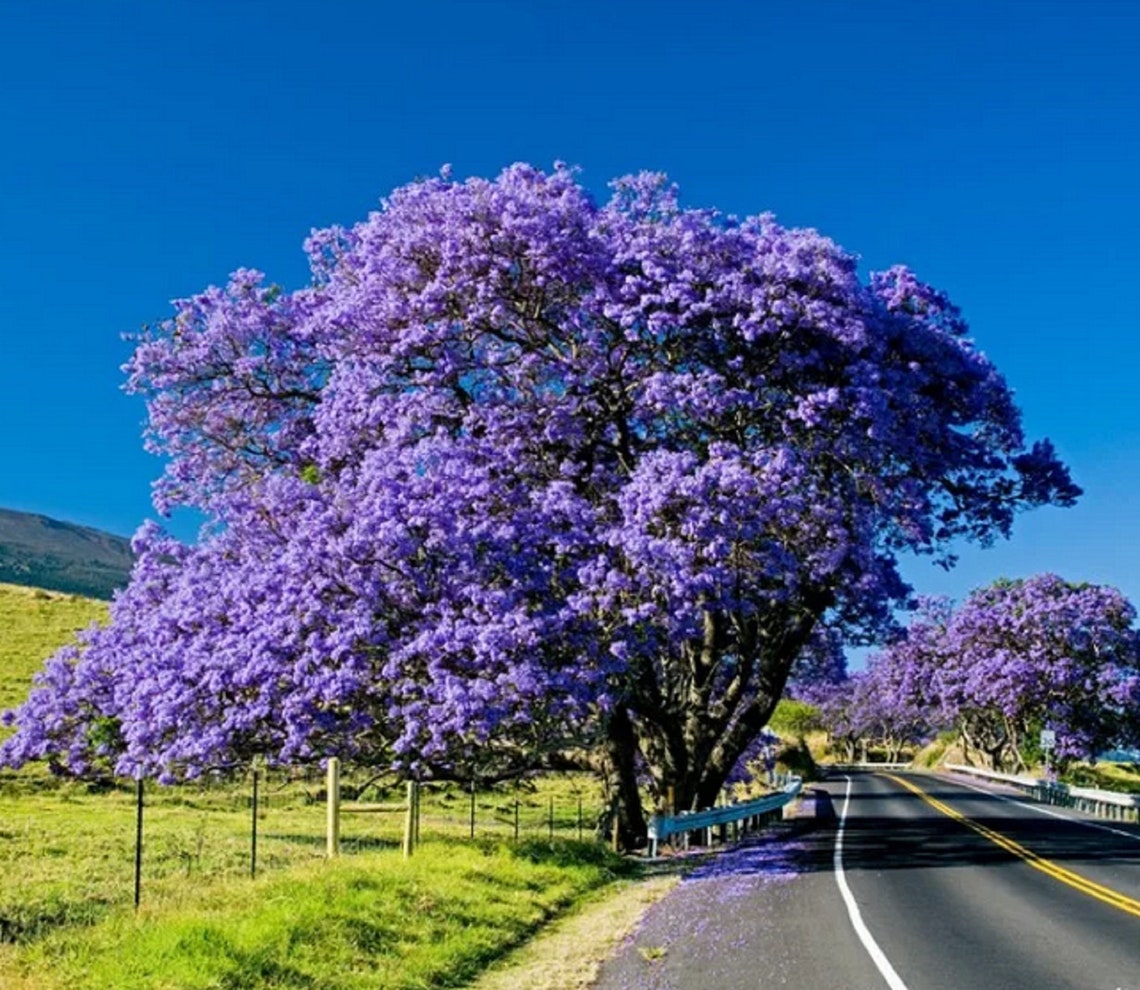

The fruit - woody seed pods - are flat, green and oval with a length of 2-4 inch, turning dark brown when ripe. It is impossible mixt of musky with a hint of honey and something unrecognized. It is not as sweet as the smell of jasmine, not as elegant as the smell of magnolia or ylang-ylang, it is not mysterious smell of white flowers in moonlight beams. This smell, the smell of jacaranda, is special. When fallen, drying leaves have their own fragrance, filling the air around the trees. The strongest odor is actually the dried leaves accumulated underneath the tree. The flowers themselves have a very faint sweet smell to it. Fern-like foliage lends volume to its bold, dramatic silhouette for a landscape look unlike any other. Incredible, long-lasting purple blooms in spring give way to rich, yellow hues in the fall, making the Jacaranda Tree a season-to-season star that stands out. Hypnotizing bluish-purple, trumpet-like flowers create the magical image of the tree. When the trumpet-shaped blooms finally fall, they form a lilac carpet beneath the awe-inspiring Jacaranda for luxuriant curb appeal. They appear in spring and early summer, and last for up to two months. The flowers are up to 2.0" long, and are grouped in 12" panicles.

When the flowers fall, the Jacaranda restores its foliage and a new cycle begins. When it blooms, it presents a profusion of flowers in clusters. These leaves are up to 18 " long and bi-pinnately compound, with leaflets little more than 0.4" long.īefore blooming, Jacaranda loses almost all its leaves. Jacaranda is cultivated for the sake of its large compound leaves, even in areas where it rarely blooms. The twigs are slender and slightly zigzag they are a light reddish-brown. Its bark is thin and grey-brown, smooth when the tree is young but eventually becoming finely scaly. In native favorable conditions, this tree can grows to a height of up to 60ft. These trees are really cosmopolitans, they have been introduced to most tropical and subtropical regions to the extent that it has entered the popular culture. The most often seen is Jacaranda mimosifolia, and more rare one is Jacaranda obtusifolia (Blue Jacaranda). The generic name is also used as the common name. Several species are widely grown as ornamental plants throughout the subtropical regions of the world, valued for their intense flower displays. Jacaranda is a genus of 49 species of flowering plants in the family Bignoniaceae, native to tropical and subtropical regions of the Southern Americas. Fragrance are from the lightly scented blooms but fragrance from the cream-pink toned wood with beautiful streaks. So they told that the Guarani word Jacaranda meant fragrant. The traditional range of the Tupi-Guarani people that extended over parts of Paraguay, Uruguay, Argentina, Brazil, and Bolivia was also home to the tree named Jacaranda. After she fulfilled her mission, she returned back to the tree adorned in Jacaranda blooms and ascended to the heavens where she united with her promised one, the Son of the Sun, who had fulfilled a similar mission in another part of the jungle. She shared with them her knowledge, wisdom and ethics, showing them the difference between good and evil. The priestess, called Daughter of the Moon, descended from the tree and lived among the villagers. When the trumpet-shaped blooms finally fall, they form a lilac carpet beneath the awe-inspiring Jacaranda for luxuriant curb appeal.Īccording to an Amazon Tupi-Guarani tribe legend, a beautiful bird called Mitu landed atop a Jacaranda tree, bringing a beautiful indigenous priestess with it. Hypnotizing bluish-purple, trumpet-like flowers create the magical image of the tree. The Purple Tango of Hypnotizing, Awe-inspiring Jacaranda She has has been with TopTropicals since Day One (2002), writing about magic plants, travel, and of course cats -įrom the CatNation she belongs to. By Alex Butova, the Witch of Herbs and CatsĪlexandra Butova is our columnist, journalist, and photographer, living in Riga, Latvia.


 0 kommentar(er)
0 kommentar(er)
